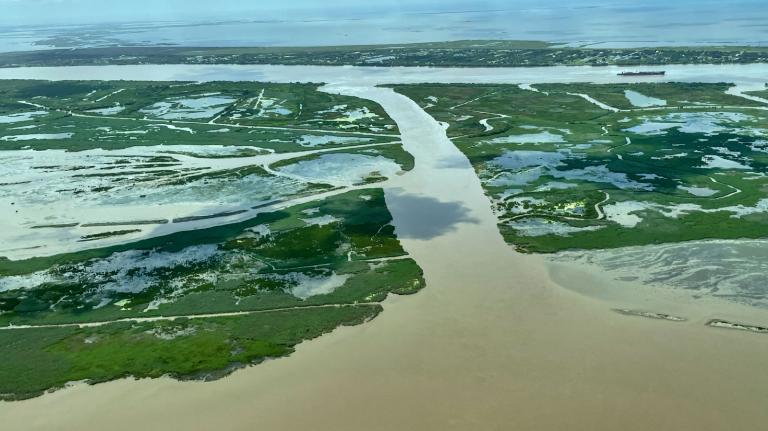The Biden administration is proposing a major overhaul to the National Flood Insurance Program, or NFIP — the main source of insurance for homeowners who are required to or choose to obtain coverage for flooding. Last month, Alice Lugo, assistant secretary for legislative affairs at the Department of Homeland Security, put forth 17 legislative proposals that would collectively represent the biggest reform to the Federal Emergency Management Administration’s National Flood Insurance Program since the program’s inception.
The proposals, which have to make their way through a politically polarized Congress before they can become law, have the potential to drastically alter the way Americans protect their homes and businesses against flooding. At the moment, 21 states have no laws in place requiring sellers to disclose whether the property they are selling has flooded or sustained water damage before, and if it is likely to flood again. The Biden administration wants to change that by implementing a nationwide disclosure law that would ensure that prospective homeowners and renters have a property’s flood history in hand before signing a contract.
Even more radically, Americans hoping to build new homes on eroding beaches and other flood-prone areas will have to look elsewhere for flood insurance if the administration’s proposed reforms pass. One of the proposals in Lugo’s letter would prevent the NFIP from insuring newly built homes in risky areas, which means homeowners who go ahead with such construction would have to go to private insurance companies, which typically offer more expensive premiums, for insurance. The same applies to people who hold mortgages on properties that flood repeatedly. People who own “excessive loss properties,” or properties that flood multiple times and require insurance payouts of at least $10,000 each time, could lose access to government insurance on their properties after the fourth claim. And the NFIP would not issue any new insurance policies for commercial buildings point blank, no matter where they’re located or when they were built, because FEMA says it wants to promote growth in the private flood insurance market.
These changes, and the rest of the proposals in the letter, are more evidence that the climate crisis — and the myriad expenses that come with it — are forcing the nation to rethink the status quo. But experts say the administration’s proposals may have mixed results and raise major questions about the mission of the public flood insurance program.
For decades, the NFIP has been hemorrhaging money as flooding has hit Americans across the United States with increasing intensity. That’s been, in part, by design. The federal government never intended for the NFIP to generate a profit like a private insurance company would. The NFIP was established by necessity: Flooding was, and still is, difficult to insure against. It creates a lot of correlated risks — it’s rare for a single house to flood in a flooding event; more commonly, multiple houses flood in the same neighborhood or town. Private insurers just weren’t up for insuring against flooding; starting in the 1920s, the industry decided that flood insurance would never be a profitable enterprise. (Some companies have since changed their tune.)
So the NFIP was formed by Congress in 1968 to provide a public option, which was, the federal government figured, better than no option at all and cheaper than bailing people out every time a hurricane or other major flooding event occurred. The NFIP now covers roughly 5 million Americans — anyone living in a floodplain, as designated by FEMA, and carrying a federally-backed mortgage is required to have it. But the program is in the red after years of consecutive major hurricanes and decades of charging policyholders discounted rates for flood insurance — it carries $20.5 billion in debt to the Treasury Department and pays $300 million in annual interest. The status quo, according to the Biden administration, isn’t working anymore.
That’s where these reforms come in. In addition to putting a national flood insurance standard in place, banning insurance for new homes in flood-prone areas and commercial buildings, and canceling insurance for excessive loss properties, the administration is asking Congress to wipe out that $20.5 billion in debt and set up a subsidy program so that lower-income Americans can afford flood insurance. Rob Moore, a senior policy analyst at the Natural Resources Defense Council and an expert on flooding, thinks that giving the NFIP a clean slate is a great idea. “It’s really encouraging that FEMA has put this out,” he told Grist.
But Moore and other flooding experts flagged concerns about some aspects of the proposal — namely, the portion that would require FEMA to drop flood coverage for “excessive loss” properties. The reforms might discourage new construction in flood-prone areas, Miyuki Hino, an assistant professor at the University of North Carolina at Chapel Hill and an expert in climate risk and adaptation, told Grist. But it’s less clear whether the reforms would actually lead to a measurable reduction in the number of people living in flood-prone areas across the U.S.
“Some of the people who live in flood-prone places, they’re not there because it’s a beach house and they love the amenity of being near water,” Hino said. “They’re there because that’s the housing that’s affordable or their family has owned the house for generations and they don’t have real alternatives.” If those homeowners aren’t able to obtain insurance through the NFIP, they may choose to forgo flood insurance altogether instead of endeavoring to move or get potentially more expensive coverage through a private insurer. That would leave them more vulnerable the next time their home floods. Hino would have liked to see the Biden administration provide more alternatives for these types of homeowners and bulk up government assistance, either to help people elevate their houses (which would, in some scenarios, allow them to participate in the NFIP even if their house has flooded multiple times) or to move somewhere else.
The existential question at the heart of the conversation around what to do about public flood insurance in this country comes down to this: Should a program that was established to fill a void left by private insurers, to ensure that Americans wouldn’t be left financially devastated by flooding, be expected to be financially solvent, or is it enough that it serves a public good? “There are ways in which that goal of making insurance available and affordable runs counter to the goal of having it run like a private insurance company,” Hino said. The flood insurance program doesn’t exist to generate revenue for the federal government, Moore pointed out. “We don’t require the Department of Defense or the Department of State to run in the black,” he said. “I don’t think the NFIP is a failure if it doesn’t run a profit.”
Both Hino and Moore agreed that the Biden administration’s proposal to establish a national flood disclosure standard would be an unmitigated win for homeowners and the federal government alike. More information in the hands of buyers and renters provides a layer of protection against flooding that is especially crucial as the climate crisis continues to throw the nation’s hydrological cycles out of whack. But it’s not clear that even that fairly uncontroversial proposal stands a chance of passing Congress. “This has as much chance of passing both houses and being signed into law as any other bill that’s in Congress right now,” Moore said. “That’s a little bit of a back-handed compliment.”
Despite the political gridlock dogging the U.S. Senate, there’s evidence that there’s an appetite for exactly these kinds of flood insurance reforms among Republicans. In 2017, the Trump administration proposed a set of reforms that look nearly identical to the proposal the Biden administration is touting now, down to the national flood disclosure standard. The similarities between the two proposals didn’t sit right with some Democratic lawmakers. “It’s unacceptable to see FEMA taking cues from the Trump administration on reforms for the NFIP,” Senator Robert Menendez, from New Jersey, told E&E News in a statement. But the fact that the Trump and Biden administrations, so often on opposing ends of the spectrum when it comes to climate policy, agree on the matter of flood insurance reform indicates that public servants on both sides of the political aisle think the status quo is becoming unsustainable.




